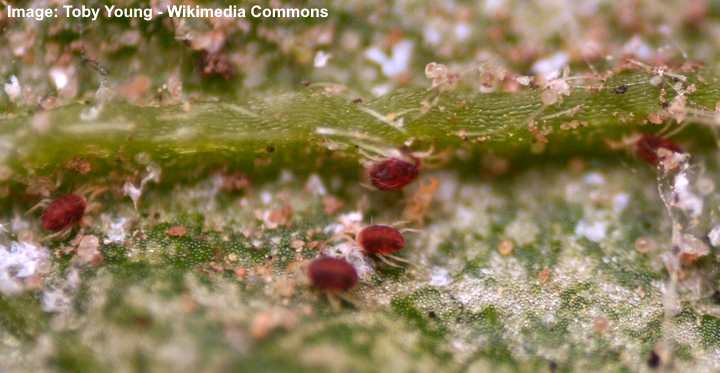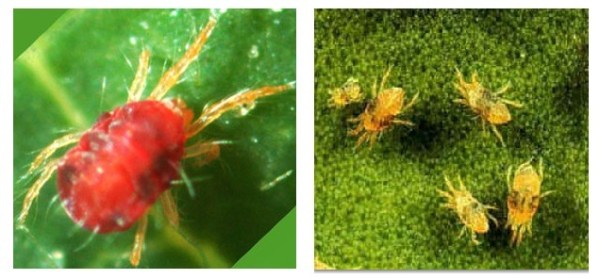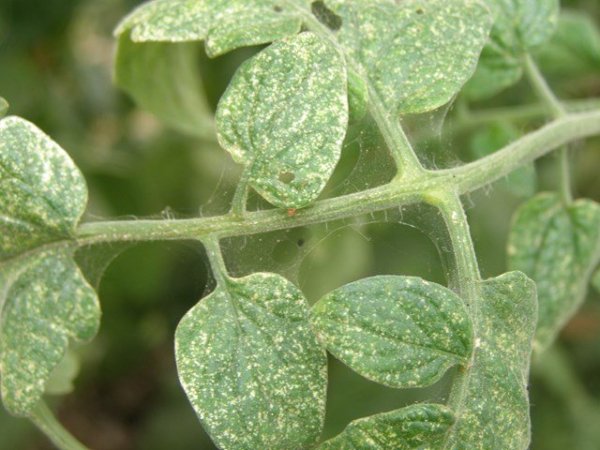Red spider or red spider mite on plants: How to eliminate with home remedies

The red spider or spider mite, like aphids, reproduces very quickly and can cause very severe damage in a short time. In today’s article we will see what damage the spider mite causes in tomatoes and other vegetables, as well as the keys to prevent and eliminate the spider mite at home with ecological remedies.

First of all, you must be vigilant to intercept the spider mite in your garden and, if it is present, fight with all possible means to eliminate the mites from the plants.
What is the red spider, red mite or red spider mite?
The red spider, red mite or spider mite (Tetranychus sp.) is a very small mite, less than 1 mm. Due to its small size, it can only be clearly differentiated with a magnifying glass. If it is present in your crops, you can find it on the ground (where it lays eggs and also hibernates) or forming colonies on the underside of the leaves, where it lives feeding on the sap it sucks from them.
What crops does the red spider attack?
Tetranychus sp. It is one of the most common pests in the garden as it is very polyphagous. In other words, it can affect almost all crops in the garden: aubergine, pumpkin, peas, lettuce, melon, potato, pepper, cucumber, bean, strawberry, corn… and also ornamental plants such as roses or chrysanthemums.
How does the spider mite affect plants? Symptoms and damage
Its sucking mouthparts cause discolorations or whitish or yellowish spots to occur on the leaves. These spots occur around the points where the spider mite sucks the sap.
In addition, the spots can increase, dry out and cause the entire sheet to dry out and peel off. As a consequence of these damages in the leaves, the photosynthesis of the plant is reduced. The plant can become quite weak, reducing the quality and quantity of the harvest. This pest is very common in tomato cultivation.

The underside of the leaves may be covered with a silky, spider web-like tissue where the mites live and roam. Also, sometimes spider colonies can cause small bulges in the bundle.
In addition to these more «visible» damages, the spider mite can also transmit viruses if it has been in contact with a diseased plant before.
Red spider mite prevention
Eliminate the remains of crops from previous harvests well, especially if they have had red spider mite, and control weeds so that these mites do not stay near where our crops will be, are two very appropriate preventive measures.
Paying sufficiently and with a quality fertilizer, such as compost, will favor the natural resistance of the plants in your garden to pests and diseases.
Mites prefer hot and dry conditions, so humidity can negatively affect them and help reduce colonies. Spray the undersides of leaves with water if you have signs that they are coming into your garden or to prevent them from getting comfortable and staying on the leaves.
Also as a preventive method you can spray the underside of the leaves with the preparation of Cola de Caballo, an infusion of nettle or other remedies for mites that we will see below.
How to eliminate red spider infestation with ecological remedies
The first thing will be to eliminate the diseased parts of the plant, such as the dry leaves that are no longer going to recover. Then combine some of the following home remedies to eliminate pests so that a good » integrated fight » ends the red spider infestation.

Natural preparations to eliminate the red spider
These are some of the home remedies to combat red spider mite:
- fern infusion
- Nettle slurry.
- Garlic insecticide. There are several options for making an insecticide from garlic. I explain some of the possible preparations:
- Garlic marinade: Marinate a few peeled and minced garlic cloves (about 100 grams) in a couple of tablespoons of oil overnight. Then mix with 1 liter of water and spray on the underside of the leaves diluted to 5% (half part of the garlic solution per ten of water).
- Alcoholic garlic broth: beat four or five cloves of garlic together with half a liter of alcohol and half a liter of water. Then strain the mixture and keep it in a covered pot or jar in the fridge. When applying, dilute and spray on affected crops.
How to eliminate red spider infestation with ecological insecticides
There are several types of organic remedies for spider mites that you can buy and, although they do not come from plants, they are natural insecticides that are used on organic crops.
Examples of ecological remedies for red spider:
- Pyrethrum
- potash soap
- paraffin oil.
- neem oil
- Sulfur (spraying with products that contain sulfur or the use of wettable sulfur is an effective remedy to fight against mites such as the red spider).
You have to be careful with these products and take a series of precautions for the application of oils and other ecological insecticides for red spiders.
The fact that they are ecological does not mean that they cannot be toxic, so we will have to be careful. These red spider remedies should not be applied in full sun and are not compatible with the application of sulfur, so you should leave a few days between the two treatments.
You can find more information about these and other remedies to eliminate the infestation of spider mite in the article on natural insecticides.
Natural enemies of the red spider
There are several mites that feed on this pest and that can be very useful to eliminate the red spider mite from plants through «biological control or biological control».
In this case you cannot capture them as you could with ladybugs or other larger natural enemies, but there are commercial products that contain thousands of predatory mites in their composition that you can buy from companies dedicated to biological pest control. The most used and effective are products with mites:
- Amblyseius cucumerisno
- Amblyseius californicus or Neoseiulus californicus
- Phytoseulus persimilis
There is also a mosquito that feeds on red spider mite: Feltiella acarisuga, which quickly detects populations of this pest in the orchard, and settles where there are populations of red spider mite. When it is a larva, this mosquito feeds on red spider eggs, nymphs and adults, and can eat up to 30 individuals a day.
References
- Ferragut, F. et al., 1992. Bases for the use of phytoseiids in pest control of horticultural crops. III International Symposium on «Integrated Pest Control in Horticultural, Fruit and Citrus». PYTOMA Spain, nº 40 Jun/Jul 19912, p. 60-67.
- Soler-Salcedo, E. et al., 2006. Colonization, feeding behavior and damage production in spider mites Tetranychus urticae and T. turkestani (Acari, Tetranychidae). Plant Health Bulletin. Plagues, nº 32, p. 523-534.
- O’Farrill-Nieves, H. & Medina Gaud, S., 2007. Common garden pests, identification and integrated management. University of Puerto Rico, Agricultural Extension Service.
So far, everything I can tell you, for now, about the red spider. I hope it works for you!



![Photo of Prune Capers: [Importance, Time, Considerations and Steps]](https://www.complete-gardening.com/wp-content/uploads/2021/06/Alcaparra_1615296745-390x220.jpg)